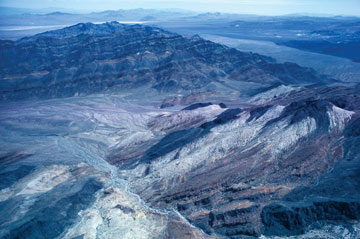|
NEWS NOTES
Mantle gas points to geothermal energy
| Amid the valleys and ridges of the Basin and Range Province in the western United States, gases from the mantle are finding their way to the surface. |
Ancient gases trapped in Earth’s mantle during the planet’s formation can escape to the surface via gas-rich magma erupting from volcanoes. But volcanoes are not the only vent for these gases — mantle gases find their way to the surface in non-volcanic regions, too. And a new idea about how they manage to escape may help to pinpoint future sources of geothermal energy.
Earth’s mantle is made up not only of molten and solid rock, but also contains volatile gases such as carbon dioxide, water vapor and noble gases. To escape to the planet’s surface, however, the gases have to take a long and complex journey: They need to penetrate both the warmer, flexible lower crust and the cold, brittle upper crust. Volcanoes, where gas-rich magma rushes up from the mantle through the crust, provide one well-known conduit for the gases. But scientists have also found evidence that mantle gases are leaking from non-volcanic regions such as the western United States’ Basin and Range Province, wrote B. Mack Kennedy, a geochemist at the Lawrence Berkeley National Laboratories in Berkeley, Calif., and Matthijs van Soest, a geochemist at Arizona State University in Tempe, Nov. 30 in Science.
The Basin and Range Province, a series of wide valleys and high ridges that spans eight U.S. states and parts of Mexico, began to form about 20 million years ago as the region extended, thinning the crust. As a result of this stretching, a series of faults cracked through the upper crust, and some blocks of the crust dropped down between these faults, creating a succession of basins and highlands.
Those faults alone aren’t deep enough to penetrate to the mantle to provide a route for gases to escape, Kennedy and van Soest say. In the more pliable lower crust, fractures would not remain open long-term, making the faults a poor conduit for mantle gases. However, fluids flowing through the shallow crust in the Basin and Range contain gases with a distinct mantle signature: a relatively high abundance of helium-3.
How the helium-3-rich gases got there is the mystery that Kennedy and van Soest set out to solve. The ratio of mantle-derived helium-3 to helium-4, a radiogenic isotope of helium found abundantly in Earth’s atmosphere, increases from east to west across the Basin and Range — which corresponds to Global Positioning System (GPS) data indicating both an increase in speed and a change in direction (from west to northwest) for the moving Pacific Plate, they found.
Those changes may be creating a much stronger stress on the crust in the western part of the Basin and Range — and that could be helping drive stronger fluid flow through not only the upper crust but also through the lower crust and into the upper mantle, Kennedy and van Soest wrote. Their suggestion that the mantle-stamped helium isotopes are related to a “twisting” of the fault blocks as they pulled apart “seems plausible,” says David Hilton, a geochemist at the Scripps Institution of Oceanography in La Jolla, Calif. “You need a high pore pressure to maintain these cracks,” Hilton says. “It only gets through the crust in regions of high permeability.”
Furthermore, the helium isotopes indicate a region of high heat production and permeable crust — both useful for identifying potential geothermal sources, Hilton says. Well-known geothermal resources in Iceland, Japan and the Philippines are in volcanic and subduction zone environments, he says. “You wouldn’t necessarily think to look in the middle part of the continent for these natural hydrothermal systems.” The tectonic mechanisms that increase the permeability and fluid pressures in the Basin and Range, however, may be one way to transport hot geothermal fluids without magma.
Helium-3, Hilton says, “is a useful indicator in this respect,” as it only comes from the mantle and can only get through the crust in regions of high permeability. “I think this paper may be a spur to others to go looking for [other] localities.”
Links:
Earth Science World Image Bank

 Subscribe
Subscribe



